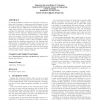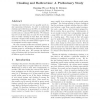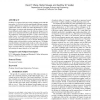157 search results - page 1 / 32 » Detecting semantic cloaking on the web |
WWW
2006
ACM
14 years 5 months ago
2006
ACM
By supplying different versions of a web page to search engines and to browsers, a content provider attempts to cloak the real content from the view of the search engine. Semantic...
AIRWEB
2005
Springer
13 years 10 months ago
2005
Springer
Cloaking and redirection are two possible search engine spamming techniques. In order to understand cloaking and redirection on the Web, we downloaded two sets of Web pages while ...
AIRWEB
2006
Springer
13 years 8 months ago
2006
Springer
Cloaking is a search engine spamming technique used by some Web sites to deliver one page to a search engine for indexing while serving an entirely different page to users browsin...
CCS
2011
ACM
12 years 4 months ago
2011
ACM
Cloaking is a common “bait-and-switch” technique used to hide the true nature of a Web site by delivering blatantly different semantic content to different user segments. It i...
SAC
2009
ACM
13 years 9 months ago
2009
ACM
The Semantic Web and its technologies become increasingly important. As more and more Semantic Web applications are being used, developing more stable Semantic Web applications be...



